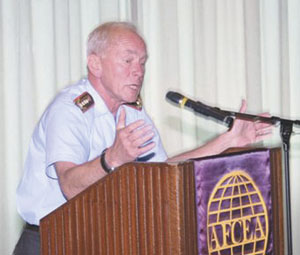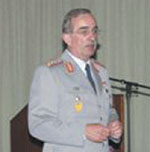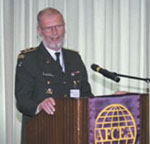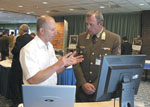International Leaders Call for Strategies and Changes That Support a Stronger NATO
 |
| Gen. Rainer Schuwirth, GEAR, chief of staff, Supreme Headquarters Allied Powers Europe, questioned why it is so difficult for military communications to achieve the same levels of affordable interoperability that commercial companies offer their mobile telephone users. |
Better intelligence and information management are key elements of a NATO transition from crisis response to crisis prevention. And nations need to be more willing to share in efforts to seek ways to create efficient multinational support capabilities rather than individual national structures, according to Gen. Rainer Schuwirth, GEAR, chief of staff at Supreme Headquarters Allied Powers Europe.
Speaking at AFCEA Europe’s 5th annual Supreme Headquarters Allied Powers Europe (SHAPE) conference, now the Allied Command Operations (ACO) event, Gen. Schuwirth shared these comments as part of the four-star view of NATO’s expanding global reach. The topic of the conference focused on deployability with much attention on the NATO Response Force (NRF), which is expected to achieve full operational capability in June 2006 after a major exercise on the
Gen. Schuwirth also discussed the air-policing role of Kosovo Forces in the Balkans; the support that NATO is giving to the European Union in Bosnia-Herzegovina; the ongoing maritime operations in the Mediterranean (operation Active Endeavor); the International Security Assistance Force in
Too many capability packages were founded upon Cold War thinking and scenarios, the general explained. NATO needs to be more courageous and say “stop” so that budgets can be freed up and switched to more relevant requirements. Gen. Schuwirth left the audience with the question, If individual commercial companies could make mobile telephones to standards that allowed any user to talk to any other user, why was it so difficult for military communications to achieve the same levels of interoperability without hugely expensive and lengthy programs?
Lt. Gen. Ulrich Wolf, GEAR, director of the newly created NATO Communication and Information Systems Services Agency, saw his mission as supplying end-to-end information exchange in the most cost-effective way. He examined the service interfaces that support the operations that Gen. Schuwirth had covered with a focus on satellite communications. Prior to NATO SATCOM Post 2000 (NSP2K), the satellites designated NATO IV A and B provided connectivity. After NSP2K, there will be five satellites, three provided by the
Also at the symposium, Maj. Gen. Georges D’hollander, BEAR, director of the NATO Headquarters Consultation, Command and Control Staff (Director NHQC3S), emphasized that today’s separate networks, interface exchange gateways and supporting policies need to change. He said that the NATO network-enabled capability is the way forward. Gen. D’hollander reviewed the cognitive, information and physical domains to highlight where improvements will occur. Transformation, interoperability and standardization are the benchmarks for change, he added.
With these benchmarks in mind, Capt. Roberto Ferrante, ITNA, Allied Command Transformation, stressed that “deployable” means the ability to bring forces and material into action. ACT is very involved in shifting from the concept of static, hardened bunkers to deployable command and control assets supported by the appropriate communications and information systems (CIS) facilities. This shift is being achieved by two important capability packages that are being developed to guarantee the funding for the equipment upgrades. These upgrades include NSP2K with space and ground segments covering ultrahigh frequency and super high frequency and plans for extremely high frequency in 2010.
Brig. Tim Waugh, UKAR (Ret.), chief of the communications and sensor systems branch, Acquisitions Division, NATO C3 Agency, explained that equipment procurement needs a clear requirement, an understandable concept, defined funding and a timeline for fielding. The requirements listed in the capability package must be fixed before the agency can run a procurement competition, he said. Users need to understand the effect of changes and should be alert to risk factors when taking unique deployability requirements into account. ACT is providing research and development funding to the NATO C3 Agency for its NRF work, but as yet no supporting capability package exits, he shared.
Rear Adm. Federico Solari, ITNA, assistant chief of staff (ACOS) J-6 at NATO Joint Force Command Naples, gave a detailed briefing on the four exercises that had been run—three in 2004 and one in 2005—to test NATO’s emerging deployment doctrine. Each exercise highlighted different challenges as the plans were amended to reflect last-minute command decisions. The supporting CIS needed to be flexible to cope with the deployable Joint Task Force concepts, he explained. Careful planning, firm management and wide-ranging coordination were the keys to successful exercises, and much work had gone into drawing out relevant lessons learned.
Brig. Gen. Luis Aguado Gracia, SPAF, ACOS J-6, ACO, suggested that his operational capabilities and options were at times frustrated by lack of resources, including manpower; by NATO’s contractual procedures; and by rapidly changing operational situations. He detailed where NATO facilities were deployed, often outside the boundaries of NATO, and where efforts were being made to shift to either selective contractor services or to fully commercial solutions, whichever suited the local circumstances best. Brig. Gracia said that late political endorsement and a reluctance, by the nations, to outsource meant that service provision was often last-minute and fractured, but that nevertheless he was confident that his team was supplying a thoroughly professional service to end-users.
Two companies, Lucent and Computer Associates (CA),
 | Lt. Gen, Ulrich Wolf, director, NCSA, sees his organization’s mission as supplying end-to-end information exchange in the most cost-effective way. |
 | Maj. Gen. Georges D’hollander, BEAR, director of the NATO Headquarters Consultation, Command and Control Staff (Director NHQC3S), related that today’s separate networks, interface exchange gateways and supporting policies needed to change. |
 | Bill Peach (l) of Systematic discusses NATO issues with Brig. Gen. Otto Halmail, HUAR, NATO Communications and Information Systems Services Agency (NCSA). |




Comments